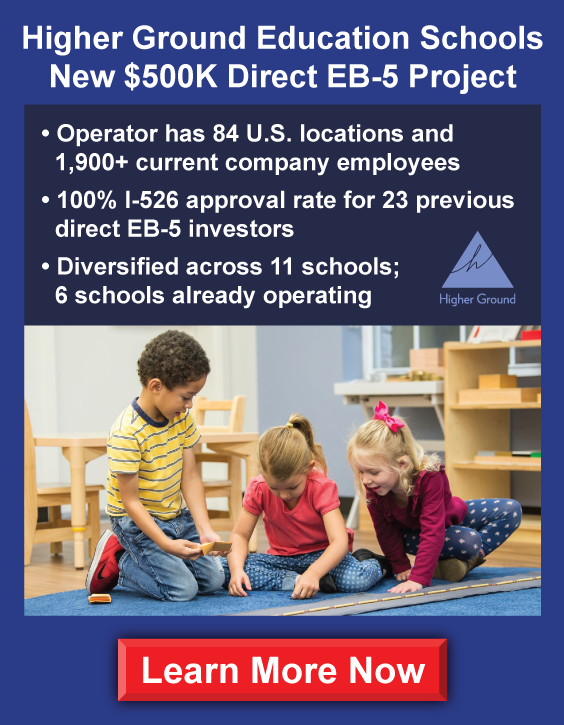EB-5 financing returns and Orlando developers have mixed feelings
The reauthorization of the EB-5 Regional Center Program is giving some developers in Orlando déjà vu.
Similarly a year following its launch, “everyone was looking at it with a skeptical eye,” developer Joshua Wallack said. It took a couple of success stories for his family’s real estate company to consider using the program in 2013 when it partnered with a development group to build a hotel in New York using EB-5 financing.
At the time, he said it was at the height of the EB-5 craze. By 2010, the federal program had raised more than $1 billion since its inception in 1990. About three decades later, EB-5 Regional Centers across the country facilitated over $33 billion in capital investments from foreign investors, while also creating a history of misuse and fickle regulations.
Similar to the past, Wallack is waiting to see if the program can yield positive results. Currently, he’s working on a partnership with Disney in Orlando to install a giant, ribbon-like art display on the Hollywood Plaza garage and is not seeking EB-financing for any active projects.
“The first choice every time is dealing with the conventional lender, but that’s not to say we don’t want EB-5 coming back,” he said “It’s going to create more diversity in the lending market, more jobs, and it will allow for more projects to get funded and create more investments into the United States.”
On Thursday, March 10th, the U.S. Senate voted in favor of federal spending the package that reauthorizes the EB-5 Regional Center Program through 2027, marking the first long-term reauthorization of the program since 2015. The legislation went into effect Tuesday, March 15.
It requires foreign investors to create a minimum of 10 domestic jobs and invest at least $800,000 or $1.05 million (depending on where the project is located) in a U.S. business venture. In return, they and their immediate family members are granted permanent U.S. residency.
Developers told GrowthSpotter they are glad to see the program be reinstated, but some are hesitant about using it for their own projects, while others are strategizing to raise equity right away.
Rodrigo Azpurua, Riviera Point’s CEO and president, said he hopes to raise $14 million in EB-Financing for a hotel project in the Miami Airport submarket and plans to raise an undetermined amount of EB-5 capital for a group of hotels at Osceola Heritage Park and NeoCity. The Miramar-based company has raised more than $100 million in EB-5 financing thus far on projects in South Florida and Orlando, including two International Drive hotels: TRYP by Wyndham Orlando, which opened in 2020, and La Quinta Inn & Suites Orlando, which opened in 2019. Azpurua says he takes pride in the 400-plus green cards the company has helped administer and believes demand for the program will remain strong among investors.
“It doesn’t matter what amount of news you watch every day, wealthy people around the world want to establish themselves here,” he said.
On the other hand, he says EB-5 financing won’t become a key fundraising mechanism for real estate projects like it was in the past when the lending markets dried up. “Now that there are lenders all around and willing to lend money, I don’t foresee it to be as popular as it was.” The regional center's program has undergone multiple interruptions and revisions to its application process like when the Trump administration increased the minimum investment to $900,000 in 2019, up from $500,000; or when legislators allowed the program to lapse last June leaving many in limbo. Stories of abuse and fraud also remain a major concern, particularly among legislators like Sen. Chuck Grassley and Sen. Patrick Leahy. The reauthorization of the Regional Center program promises to be more stringent on bad actors, like imposing sanctions if a regional center files misstatements. Park Square Enterprises CEO Suresh Gupta said the new requirements will make utilizing the program more difficult.
“There’s still a lot of unknowns, like where the ‘high unemployment areas will be,” he said. “Finding the right project in the right location will be hard.” The company no longer plans to use EB-5 equity, for the time being, Gupta said. Previously it raised $4 million from EB-5 investors to fund a WoodSpring Suites hotel in Sanford (completed two years ago) and a WoodSpring Suites hotel in Davenport (completed four years ago).
In an email to GrowthSpotter developer David Townsend said he offers payment plans to assist EB-5 investors and has a sales office in Dubai. Townsend is the master developer of City Center West Orange, a large mixed-use community in Ocoee. Its first phase is slated to consist of 600 luxury apartments and 200,000 square feet of commercial space across a mix of uses including restaurants, retail, entertainment, hotel, and office.
Townsend said he’s raised $46 million in EB-5 equity over seven years and will have 100 additional visas available for the second phase. Karen Costa, president of Orlando-based Primeland Development said the company was approved by a regional center and can offer the program to investors, but Primeland’s planned hotel/condo communities will not be relying on EB-5 financing. “What I learned from lenders is they don’t like EB-5,” she said. “So to develop under equity that is not popular is possible but not the best resource."
Primeland Development is behind Sycamore Resort Kissimmee and Sycamore Vacation Club in Orlando. Attorney Ronald Fieldstone of Saul Ewing Arnstein and Lehr in Miami says the reauthorization for five years gives the regional center program stability. “For the first time in a while, we have a program that won’t be renewed every nine months or so,” he said. The differential minimum amount an investor must put in for qualified Targeted Employment Areas and non-TEAs is not as great as it used to be and there are rural exemptions for designations with less than 20,000 people, he adds.
Fieldstone is actively engaged in deals that were either in the market before and are being modified and amended to adjust to the new legislation or working with clients on new projects using EB-5 financing. He represents both developers and regional centers in EB-5 matters and has been involved in more than 350 EB-5-related projects. According to him, the appetite for EB-5 investment remains strong.
“It’s still cheap capital, we feel the industry is going to pick back up, but I don’t know if it’s going to reach the levels it has reached before.”
Mentions
Videos





Subscribe for News
Site Digest
Join Professionals on EB5Projects.com →
Securities Disclaimer
This website is for informational purposes only and does not constitute an offer or solicitation to sell shares or securities. Any such offer or solicitation will be made only by means of an investment's confidential Offering Memorandum and in accordance with the terms of all applicable securities and other laws. This website does not constitute or form part of, and should not be construed as, any offer for sale or subscription of, or any invitation to offer to buy or subscribe for, any securities, nor should it or any part of it form the basis of, or be relied on in any connection with, any contract or commitment whatsoever. EB5Projects.com LLC and its affiliates expressly disclaim any and all responsibility for any direct or consequential loss or damage of any kind whatsoever arising directly or indirectly from: (i) reliance on any information contained in the website, (ii) any error, omission or inaccuracy in any such information or (iii) any action resulting therefrom.


